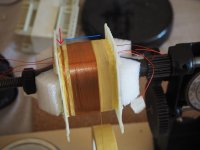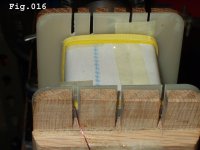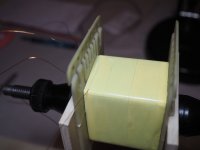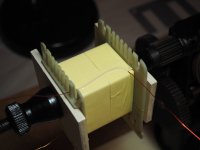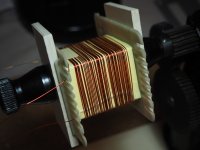I'm winding my first OPT. So far, so good.
I'm facing one single problem right now.
I'm using about 75% of the bobbin width to wind each wire layer (as seen in the image in blue).
I've already laid half the total layers, but I'm having problems at the extremes of each layer. It is very difficult to lay the wire exactly (exactly) on top of the bottom layer, so the wire tends to "slip", as seen in the image in red.
Obviously I'm doing something wrong. How should I do it? Any advices?
By the way, I isolate each layer with .06mm polyester film, and primary/secondary with 3 layers of this same film.
Thank you.
I'm facing one single problem right now.
I'm using about 75% of the bobbin width to wind each wire layer (as seen in the image in blue).
I've already laid half the total layers, but I'm having problems at the extremes of each layer. It is very difficult to lay the wire exactly (exactly) on top of the bottom layer, so the wire tends to "slip", as seen in the image in red.
Obviously I'm doing something wrong. How should I do it? Any advices?
By the way, I isolate each layer with .06mm polyester film, and primary/secondary with 3 layers of this same film.
Thank you.
Attachments
Quite an issue, especially in flangeless bobbins. To solve it, 1st design your windings in order to get solely complete (i.e. wound from flange to flange) layers. If not possible, fill with paper or cardboard of appropriate thickness. 2nd, especially when using as thin isolating material as your's, use film with finned (or sectioned, I don't know the exact term) edges.
Best regards!
Best regards!
Try this method.
xxxxxxxxxxxxxxxxxxxxxxxxxxxxxxxxxxxxxxxx insulating xxxxxxxxxxxxxxxxxxxxxxxxxxxxxxxxxxxxxxx
insulating xxxxxxxxxxxxxxxxxxxxxxxxxxxxxxxxxxxxxxxxxxxxxxxxxxxxxxxxxxxxxxxxxxxxxx insulating
xxxxxxxxxxxxxxxxxxxxxxxxxxxxxxxxxxxxxxxx insulating xxxxxxxxxxxxxxxxxxxxxxxxxxxxxxxxxxxxxxx
xxxxxxxxxxxxxxxxxxxxxxxxxxxxxxxxxxxxxxxx insulating xxxxxxxxxxxxxxxxxxxxxxxxxxxxxxxxxxxxxxx
insulating xxxxxxxxxxxxxxxxxxxxxxxxxxxxxxxxxxxxxxxxxxxxxxxxxxxxxxxxxxxxxxxxxxxxxx insulating
xxxxxxxxxxxxxxxxxxxxxxxxxxxxxxxxxxxxxxxx insulating xxxxxxxxxxxxxxxxxxxxxxxxxxxxxxxxxxxxxxx
Kay Pirinha:
I remember I read that it isn't a good idea to wind up to the flanges. That it was recommended to leave, at least .5 cm. Didn't understand why.
Wind from flange to flange is not hard to do, if I leave some space between turns (don't place each and every turn just next to the previoous one, with no gap). I suppose this will do no harm.
About the film, I'm not sure I understud what finned/sectiones edge means. I haven't seen any polyester film different from the one I use. Just thickness and adhesive varies.
Euro21:
Thank you, nice tip.
I suppose that x are turns of wire.
There're some areas of the winding not insulated?
I remember I read that it isn't a good idea to wind up to the flanges. That it was recommended to leave, at least .5 cm. Didn't understand why.
Wind from flange to flange is not hard to do, if I leave some space between turns (don't place each and every turn just next to the previoous one, with no gap). I suppose this will do no harm.
About the film, I'm not sure I understud what finned/sectiones edge means. I haven't seen any polyester film different from the one I use. Just thickness and adhesive varies.
Euro21:
Thank you, nice tip.
I suppose that x are turns of wire.
There're some areas of the winding not insulated?
Elerion,
Your polyester film is too soft, also when applying three layers.
I have been winding flangeless coils for some twenty years (and still do).
No problem with wires slipping away; the "trick" is to use stronger material.
For audio transformers I use a single layer of 0.12 mm prespane between layers of a single section.
Between sections (primary-secondary) you can apply more layers, also to improve voltage isolation.
By the way, using only 75% of winding width does not point to a very good design.
Your polyester film is too soft, also when applying three layers.
I have been winding flangeless coils for some twenty years (and still do).
No problem with wires slipping away; the "trick" is to use stronger material.
For audio transformers I use a single layer of 0.12 mm prespane between layers of a single section.
Between sections (primary-secondary) you can apply more layers, also to improve voltage isolation.
By the way, using only 75% of winding width does not point to a very good design.
Last edited:
This holds true especially for high voltage (in the region of several kV) windings, to avoid corona effects.I remember I read that it isn't a good idea to wind up to the flanges. That it was recommended to leave, at least .5 cm. Didn't understand why.
As I and Pieter t said before, leaving some of the winding space unused is not a good idea. Transformer efficiency will be reduced.Wind from flange to flange is not hard to do, if I leave some space between turns (don't place each and every turn just next to the previoous one, with no gap). I suppose this will do no harm.
We have HostaphanTM isolating film here in Germany with it's edges cut into small parts, about 2 mm deep and 2 mm wide. Total width is somewhat larger than the bobbin's distance between the flanges, so these sections will bend upward, thus preventing the wire from slipping.About the film, I'm not sure I understud what finned/sectiones edge means. I haven't seen any polyester film different from the one I use. Just thickness and adhesive varies.
Best regards!
Last edited:
This is also known as margin tape, with the same thickness as your layer wire, and can even be double-sided adhesive, so as to provide a 'solid' insulation barrier between end of layer wires, or to core.... fill with paper or cardboard of appropriate thickness.
For an OPT, you need to be mindful that the primary - secondary or primary end-to-end insulation barrier, and creepage-clearance level, could be getting up to mains transformer isolation levels with 2kV or more hi-pot testing target.
Thank you everyone! Just finished it. Six layers of primary and another five layers of secondary (to wire in parallel), and 37.5% UL tapping. Not the best OPT in the world, but I learned a lot doing it, and also from your comments.
I've used paper on the unused outside areas of the bobbin, with excelent results!
Then I also spread a little bit the wire, leaving some small gaps between some turns, so almost 90% of the bobbin is used. Then I could carry on comfortably.
I think this polyester film is great for layer insulation, but paper seems much better for interwinding insulation. But I've read many people not recommending paper, because it can burn, and claiming polyester being more reliable.
Could I use fiber cloth film? Like this one:
http://www.farnell.com/datasheets/2257004.pdf
0.18mm, high breakdown voltage and high heat resistance.
I've used paper on the unused outside areas of the bobbin, with excelent results!
Then I also spread a little bit the wire, leaving some small gaps between some turns, so almost 90% of the bobbin is used. Then I could carry on comfortably.
I think this polyester film is great for layer insulation, but paper seems much better for interwinding insulation. But I've read many people not recommending paper, because it can burn, and claiming polyester being more reliable.
Could I use fiber cloth film? Like this one:
http://www.farnell.com/datasheets/2257004.pdf
0.18mm, high breakdown voltage and high heat resistance.
No.There're some areas of the winding not insulated?
"x" is enamelled magnet wire.
The space is filled with "insulating" -same thickness as wire- for example self adhesive paper stripe.
Attachments
I only see insulation (yellow) on the edges.
xxxxxxxxxxxxxxxxxxxxxxxxxxxxxxxxxxxxxxxx insulating xxxxxxxxxxxxxxxxxxxxxxxxxxxxxxxxxxxxxxx
insulating xxxxxxxxxxxxxxxxxxxxxxxxxxxxxxxxxxxxxxxxxxxxxxxxxxxxxxxxxxxxxxxxxxxxxx insulating
According to this, there's insulation on the edges in one layer, then insulation in the middle of the bobbin, but not on the edges.
According to this, it seems that some enamel wires are on top of the ones below.
Also, when insulating in the middle of the bobbin, what do you do with the wire? It needs to cross over?
I always start on one side of the bobbin, and end winding on the other side (before going back, winding, or cutting the wire if I'm done with it).
xxxxxxxxxxxxxxxxxxxxxxxxxxxxxxxxxxxxxxxx insulating xxxxxxxxxxxxxxxxxxxxxxxxxxxxxxxxxxxxxxx
insulating xxxxxxxxxxxxxxxxxxxxxxxxxxxxxxxxxxxxxxxxxxxxxxxxxxxxxxxxxxxxxxxxxxxxxx insulating
According to this, there's insulation on the edges in one layer, then insulation in the middle of the bobbin, but not on the edges.
According to this, it seems that some enamel wires are on top of the ones below.
Also, when insulating in the middle of the bobbin, what do you do with the wire? It needs to cross over?
I always start on one side of the bobbin, and end winding on the other side (before going back, winding, or cutting the wire if I'm done with it).
Hi, i also use plastic bobbins, i use this 3mm wide masking tape as margins on either ends,
so that as you put in the interlayer paper, there are no slips....
also when winding the secondaries, maintain the same traverse widths,
even if you are not filling up a layer, you can helix wind so that the end of the coil
reaches the end of the bobbin and maintain same traverse width...
so that as you put in the interlayer paper, there are no slips....
also when winding the secondaries, maintain the same traverse widths,
even if you are not filling up a layer, you can helix wind so that the end of the coil
reaches the end of the bobbin and maintain same traverse width...
I'm building my second OPT using the lessons I learned by experience, and all those tips and help of all you .
I wonder if it is generally speaking better to start a layer by placing the wire flat along the bobbin, and wind backwards, or sticking the wire right at the begining, and wind forwards. Much better to see in the images.
I used a new desing, where I fill 144 turns out of a maximum of 150 (for the thin primary wire). Also more insulation, and paper, to avoid the wire slipping at the edges.
I'm just a little bit afraid that the turns right at the extremes can be "pulled" down, by the tension of the wire, between the bobbin wall and the insulation, to the lower layers. Is there something I can do to make sure this doesn't happend?
Thank you!!
I wonder if it is generally speaking better to start a layer by placing the wire flat along the bobbin, and wind backwards, or sticking the wire right at the begining, and wind forwards. Much better to see in the images.
I used a new desing, where I fill 144 turns out of a maximum of 150 (for the thin primary wire). Also more insulation, and paper, to avoid the wire slipping at the edges.
I'm just a little bit afraid that the turns right at the extremes can be "pulled" down, by the tension of the wire, between the bobbin wall and the insulation, to the lower layers. Is there something I can do to make sure this doesn't happend?
Thank you!!
Attachments
Are you worried that your wire will fall down in the exact edge of the bobbin and touch the lower layer?
One trick is to lay a stronger insulation that has the exact, plus a few tenths of microns more the width the bobbin,
The other trick is to use a thinner, but a few mm larger insulation. To ease the folding at the edges, precut these perpendicurarly with a 2-3mm step, so they start to look like combs at the edges.
If you decide to not use the whole bobbin width, you can also try inserting ropes/threads with approximately the same thickness of the wire.
I only wind my transformers on flangeless bobbins. It was tricky to learn at first, but once you master it, I think you might develop a certain disgust towards classic bobbins. There is a certain charm and art when going flangeless, plus the additional feel of freedom.
One trick is to lay a stronger insulation that has the exact, plus a few tenths of microns more the width the bobbin,
The other trick is to use a thinner, but a few mm larger insulation. To ease the folding at the edges, precut these perpendicurarly with a 2-3mm step, so they start to look like combs at the edges.
If you decide to not use the whole bobbin width, you can also try inserting ropes/threads with approximately the same thickness of the wire.
I only wind my transformers on flangeless bobbins. It was tricky to learn at first, but once you master it, I think you might develop a certain disgust towards classic bobbins. There is a certain charm and art when going flangeless, plus the additional feel of freedom.
Last edited:
you develop a "fist" among others...and that is very easy to teach but very hard to acquire in the beginning....
There is a lot of truth in this. The beginning can be painful, but with great patience and persistence, your results will be rewarded.
OP, if this might help you as a solace, let me share the casualties it took me to begin winding well structured, perfectly looking transformers - approximately 3kg of scrapped copper wire, lots of curses and swearing of such a nature you should not even imagine, raging, some punching into metal parts that results into bleeding fists, throwing stuff into random directions, two bent winding shafts (thankfully they're cheap).
Sadly, this is not a process that is learned by books only, although they can save you some migraines. You have to "feel" the wire and observe how each mechanical parameter influences your winding. Changing the wire diameter slightly might appear to you as if you were learning from scratch. Each thickness behaves differently. And the tension has to vary with the thickness of the wire. The insulation will also be a challenge. One insulation can have a much different feel, hardness or plasticity than another. The shape of the coil matters a lot too. Observe the winding of the first layers on a square bobbin, where the corners will be sharp. Then notice how the winding difficulty changes when they get rounded.
My favorite wires to work with for audio transformers are ranging from 0.35 to 0.7 dia, handling wise.
Last edited:
50AE, thanks for the tips!
What about the other question...
"I wonder if it is generally speaking better to start a layer by placing the wire flat along the bobbin, and wind backwards, or sticking the wire right at the begining, and wind forwards. Much better to see in the images."
What about the other question...
"I wonder if it is generally speaking better to start a layer by placing the wire flat along the bobbin, and wind backwards, or sticking the wire right at the begining, and wind forwards. Much better to see in the images."
Elerion, that depends.
If you do it the first way, that means placing the wire flat and winding on top of it, you get the advantage of self-holding this same starting lead with the coil. It's a good choice if the layer you're putting is the final one, so there are no other coils on top to hold the leads. Of course you'll have to secure the end lead.
The second option, the classical one will be appropriate if you have to wind an even number of layers - 2, 4, 6, so that the end lead will naturally come to the same place as the start lead.
Of course, I'm only mentioning practical advice here. For audio transformers, there are other factors, such as interlayer capacitance that might make you want to follow the same primary direction as the secondary, in order to minimize potential differences between turns.
If you do it the first way, that means placing the wire flat and winding on top of it, you get the advantage of self-holding this same starting lead with the coil. It's a good choice if the layer you're putting is the final one, so there are no other coils on top to hold the leads. Of course you'll have to secure the end lead.
The second option, the classical one will be appropriate if you have to wind an even number of layers - 2, 4, 6, so that the end lead will naturally come to the same place as the start lead.
Of course, I'm only mentioning practical advice here. For audio transformers, there are other factors, such as interlayer capacitance that might make you want to follow the same primary direction as the secondary, in order to minimize potential differences between turns.
Last edited:
- Status
- This old topic is closed. If you want to reopen this topic, contact a moderator using the "Report Post" button.
- Home
- Design & Build
- Parts
- Output transformer layering problem
